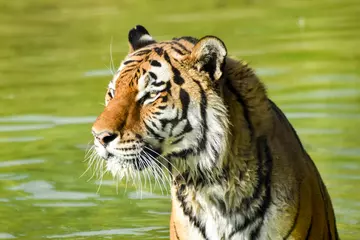

Amur tiger facts
Amur tigers are the largest of the world’s big cats, as well as the heaviest.
Amur tigers live alone in the wild and use scent marking to keep other tigers away.
Female tigers will have litters of between two and six cubs.
Amur tigers are thought to be the palest tiger subspecies and can reach up to 250kg and three metres in length!
By the 1940s, fewer than 40 Amur tigers were thought to remain in the wild. The subspecies was saved from extinction when Russia became the first country in the world to grant its resident tigers full conservation protection.
Visit our Amur tiger at Whipsnade Zoo
Meet Miron
Whipsnade Zoo is home to male Amur tiger Miron, who joined us in 2024. See him roam and explore his habitat with a visit to our Asia region of the Zoo.
What do Amur tigers look like?
Amur tigers have distinctive orange and black stripes and is the largest of the subspecies of tiger. Due to its habitat, it has a long coat of fur and a large ruff around its jawline.
What do Amur tigers eat?
Amur tigers are meat eaters, often found hunting deer, wild pigs, moose, hares and other animals that live in their habitat.
Amur tiger habitat
Originating in Russia, northern China and Korea, the Amur tiger lives among dense forest and mountains. These parts of the world experience long winters so the species can often be found against a backdrop of deep snow.

What threats do Amur tigers face?
Amur tigers are under threat from hunting and deforestation.
How is ZSL helping Amur tigers?
We're working to protect Amur tigers in the wild, using camera traps to track poaching on tigers, and by building relationships with people to increase the awareness of protecting these fantastic animals.
